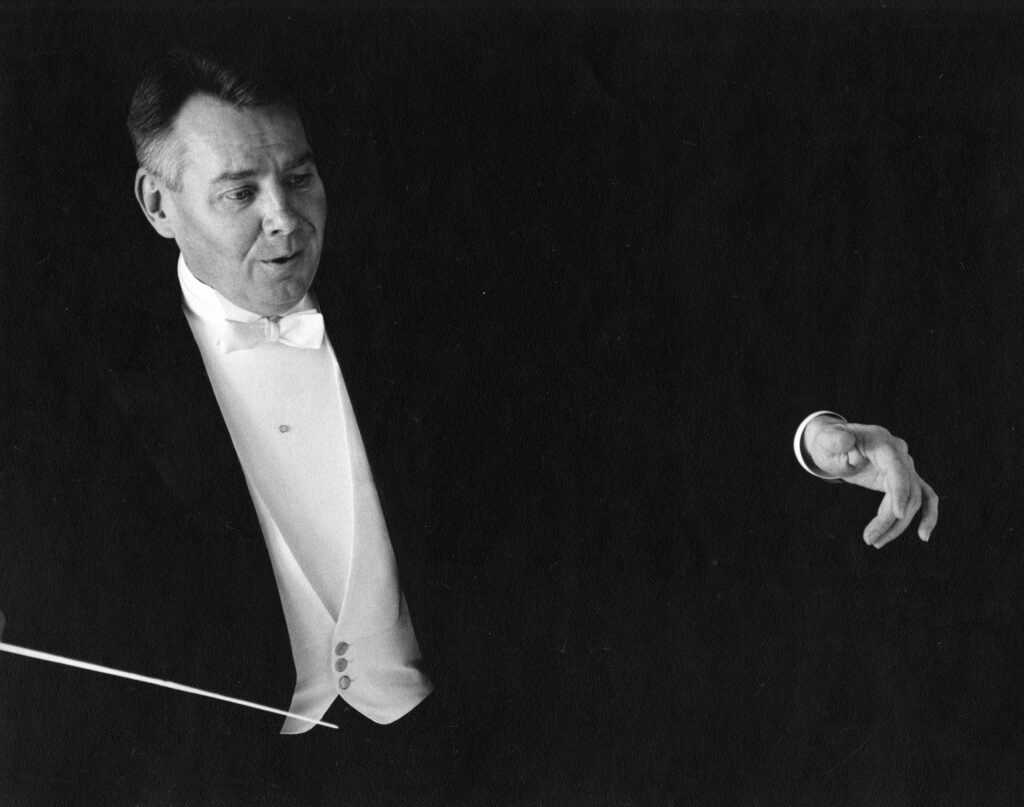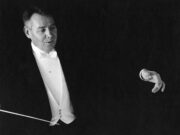What was probably Atlanta’s first notable concert occurred in February 1858 at the recently completed Athaeneum Theater, when pianist Sigismond Thalberg, assisted by violinist Henry Vieuxtemps, brought his “Grand Concert” to the city. Opera made its first appearance in October 1866, when Max Strakosch and the Ghioni and Sussini Grand Italian Opera Company opened the Bell-Johnson Hall (capacity 600) with Il trovatore (The Troubadour), Norma, and Il barbiere di Siviglia (The Barber of Seville). The next month the Grover Opera Troupe staged an operatic concert, followed by the McCulloch Opera Troupe with performances of Il barbiere di Siviglia and Don Pasquale. The lack of a suitable theater prompted the Belgian consul, Laurent DeGive, to construct DeGive’s Opera House at the corner of Marietta and Forsyth streets (capacity 1,200) in 1870; in 1873 he increased the seating to 2,000.

In February 1872 the country’s most respected conductor, Theodore Thomas, brought his orchestra to the city for the first time. The next year Ferdinand Wurm organized the city’s first serious instrumental ensemble. The year 1873 also saw the completion of five main-line railroads, which increased the number of touring companies that came to the city. During the 1870s British opera companies supplanted Italian, presenting a few Italian favorites in English. Atlanta’s first performance of an English operetta, Eichberg’s The Doctor of Alcantara, occurred in 1877, and in 1879 William Gilbert and Arthur Sullivan’s H.M.S. Pinafore made its Atlanta premiere. Several concert organizations were established in the post–Civil War period, notably the Mozart Club (1867), the Beethoven Society (1872), and the Rossini Club (1876).
The 1880s and 1890s
Atlanta gained its first resident professional musician when Alfredo Barili moved to the city in 1880. He established himself as a teacher at Mrs. Ballard’s School and began introducing many standard works, including Ludwig Beethoven sonatas and later Charles Gounod’s Messe solennelle de Sainte Cecile. Barili organized Atlanta’s first music festival in the autumn of 1883. During the three-day festival he supervised the Atlanta premiere of five major symphonic works, including symphonies by Franz Schubert (no. 8), Franz Haydn, and Beethoven, as well as a number of Felix Mendelssohn and Giuseppe Verdi overtures.
Visits by opera companies increased; the Emma Abbott Grand English Opera, Grau’s English Opera Company, and Ford’s Opera Company all made return appearances. The first week of February 1889 saw Atlanta’s first week-long operatic festival: the Emma Abbott Company staged eight operas, including Faust, Norma, Il trovatore, and Martha. In the 1890s a number of notable concert artists visited the city. Perhaps the best known was the century’s most celebrated soprano, Adelina Patti (Barili’s aunt), whose performance in January 1894 packed DeGive’s Opera House. The next year, the African American soprano Sissieretta Jones, known as the “Black Patti,” appeared. For the Cotton States and International Exposition in 1895, Victor Herbert conducted Patrick Gilmore’s Twenty-second Regiment Band, and in November 1895 John Philip Sousa brought his famous ensemble to the festival.
1900-1960
The year 1901 brought the first singers from New York’s Metropolitan Opera House under Maurice Grau, which included conductor Walter Damrosch, soprano Emma Eames, and contralto Ernestine Schumann-Heink. In 1905 the Atlanta Music Festival Association was established. It organized music festivals in 1907 and in 1909, for which it arranged a series of five concerts, featuring such famous opera singers as Enrico Caruso (who was, however, indisposed), Geraldine Farrar, and Olive Fremsted and concerts by the Dresden Philharmonic Orchestra from Germany. The festivals attracted audiences from the entire region, so the railroads provided special excursions from neighboring cities.
The highly successful festivals expanded the city’s appetite for opera, and in 1910 the Metropolitan Opera began its regular spring visits with six performances, featuring such stars as Caruso, Farrar, and Louise Homer. From 1911 to 1923 Atlanta was the only city outside the Northeast to which the Metropolitan toured. The annual visits continued, with a few interruptions, until the company ceased national tours after the 1986 season. For these and other performances, the Music Festival Association supported construction of the Atlanta Municipal Auditorium and the installation of a seventy-seven-stop Austin organ, which was inaugurated under Edwin H. Lemare in May 1910 for an audience of 7,000.
The Atlanta Music Club was formed in 1915, mainly to enrich the city’s musical life by sponsoring noted artists in recitals. Primarily a women’s organization, the club was instrumental in establishing the Atlanta Symphony Orchestra (1923), the Choral Guild of Atlanta (1939), and the amateur Atlanta Community Orchestra (1958), as well as providing scholarships for talented young musicians.
Early attempts to establish a symphony orchestra proved frustrating. The first organization to bear the name Atlanta Symphony Orchestra was formed in 1923, with sixty players drawn from the Howard and Metropolitan Theater Orchestras under the direction of Enrico Leide. In 1944 the Atlanta Music Club founded the Atlanta Youth Symphony Orchestra by merging two school orchestras, under the Chicago conductor Henry Sopkin. Two years later the group began adding professional players and changed its name to the Atlanta Symphony Orchestra. Sopkin gradually developed the ensemble into a competent semiprofessional ensemble before retiring in 1966.
1960 to the Present
A plane crash at Paris Orly Airport in France on June 3, 1962, took the lives of more than 100 leading Atlanta art patrons, who were flying home from a European tour sponsored by the Atlanta Art Association. The victims were commemorated with the construction of the Memorial Arts Center, later the Robert W. Woodruff Memorial Arts Center. The complex include Symphony Hall, the orchestra’s first permanent home, in addition to the High Museum of Art, and the professional Alliance Theatre.
A desire to upgrade the Atlanta Symphony to full professional status resulted in the engagement of Robert Shaw as music director in 1967. For his first season the orchestra numbered eighty-seven musicians. Shaw founded the Atlanta Symphony Orchestra Chorus, and under his direction the entire ensemble grew into one of the nation’s finest, winning numerous Grammy Awards. After serving for twenty-one years Shaw was appointed music director emeritus and conductor laureate; he died in 1999. Yoel Levi directed the ensemble from 1988 to 2000 before becoming music director emeritus. Robert Spano became music director in 2001 and served until the appointment of Nathalie Stutzmann in 2022. Stutzman became the first woman to direct the orchestra and only the second woman to lead a major American orchestra.
Like the symphony orchestra, opera experienced difficulty in establishing itself in Atlanta. The city’s first resident professional company was bankrupted through mismanagement after its first performances of Henry Purcell’s King Arthur in 1968 in the Memorial Arts Center. In the mid-1970s two ambitious professional companies appeared: the Music Theatre Guild of Atlanta (1974) and the Atlanta Lyric Opera (1976). In 1977 the former company, renamed Georgia Opera, moved to the Woodruff Arts Center and added an orchestra. In 1979 the two companies merged to form the Atlanta Civic Opera, which was plagued by financial problems. In 1985 the company was reorganized with William Fred Scott as conductor and artistic director, and Alfred Kennedy as general manager. Since then Atlanta Opera has achieved a strong professional level of performance and has become the largest operatic organization in the Southeast.
The start of the twenty-first century also saw Atlanta’s thriving choral and organ tradition grow in stature. Among the notable organs built earlier were the magnificent Flentrop organ at St. Ann’s Episcopal Church, the large Aeolian-Skinner at the Cathedral of St. Philip, and the Rosales organ at St. Bartholomew’s Church. To these have been added such large instruments as the Létourneau organ at the Lutheran Church of the Redeemer and the Mander organ at Peachtree Road United Methodist. Also notable is the Möller theater organ at the Fox Theatre, one of the city’s important concert venues.
Atlanta is home to many choral and instrumental groups including the Atlanta Singers, the Atlanta Boy Choir, the Pro-Mozart Society of Atlanta, and the Atlantic Lyric Theatre. Several chamber groups have also achieved wide respect, notably the Atlanta Chamber Players, and Thamyris, which specializes in contemporary music.
Virtually all the universities, colleges, and junior colleges in Atlanta provide some musical instruction. The most important is the School of Music at Georgia State University. Its Rialto Center for the Performing Arts is one of the finest medium-sized concert halls in the area. Two predominantly Black colleges, Spelman and Morehouse, provide advanced music training programs as well. Spivey Hall at Clayton State University has established one of the area’s signature concert series, presenting a broad range of performances throughout the school year. Emory University’s Flora Glenn Candler concert series presents programs in the new Donna and Marvin Schwartz Center for the Performing Arts.






